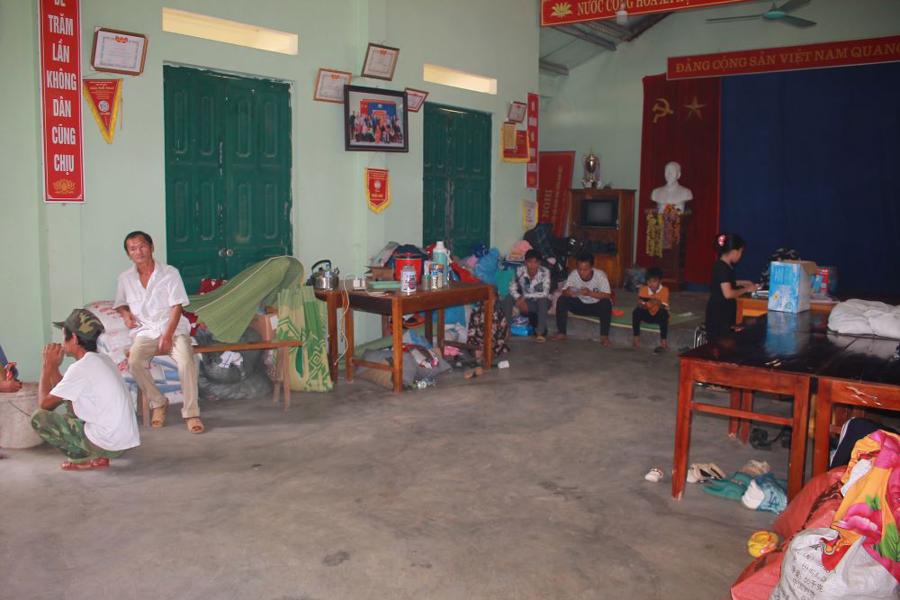Bac Ha district, Lao Cai province, was one of the areas most devastated by the recent natural disaster caused by Storm No. 3. At the Met Ngoai hamlet cultural house in Bao Nhai commune, six households with 37 people are currently taking shelter in cramped conditions, having lost their homes. From the cultural house at the foot of the mountain, they pointed up to the peak to show us a reddish area. That was Met Thuong hamlet of the six Dao households.
LANDSLIDE, COLLAPSED HOUSES, AND PEOPLE SWEPT AWAY BY FLOODS
Mr. Tran Dinh Tien, head of Met hamlet, Bao Nhai commune, Bac Ha district, said that on September 10, 2024, when they heard the sound of the mountain cracking like a bomb, everyone in the village ran down to the foot of the mountain. Soon after, a landslide wiped out all six houses.
Mett hamlet consists of three hamlets: Met Thuong, Met Ngoai, and Met Trong, with a total of 181 households. Of these, Met Ngoai hamlet has 44 Hmong households, while Met Thuong hamlet is entirely Dao.
“Currently, in addition to the six families who have been evacuated here, there are still 22 other households on the mountainside living under the constant threat of an impending landslide. A massive block of land could collapse at any moment. For now, we don’t know where to relocate the six households who have lost their homes and the 22 households in danger. We can only wait for the commune and district to decide on a solution,” said Tran Dinh Tien, head of Met hamlet.

Mr. Tien also said that during Storm No. 3, along with the landslide on the mountain, the area at the foot of the mountain was flooded. Some houses were submerged in 3-7 meters of water. As a result, all the rice, corn, and crop fields were completely inundated and destroyed. Now the water has receded, but both rice and corn have turned yellow and withered.

Leaving Bao Nhai commune, we continued to the remote areas of the district. At Nam Tom bridge, small cars and light trucks could no longer pass. We had to travel by tractor along the Chay River. On one side of the river was Coc Lau commune, and on the other was Nam Luc commune. The sight along the way was terrifying. Not only had the landslide covered most of the road, but the ground on the road was also cracked wide open.

According to Mr. Nguyen Van Tuan, Chairman of Coc Lau Commune People’s Committee, due to the influence of the peripheral circulation of Storm No. 3 (Storm Yagi), from the night of September 7 to the morning of September 9, heavy rain occurred in Coc Lau Commune, Bac Ha District. The massive flood on the Chay River in the early morning of September 9 caused six houses in Nam Dan hamlet, Kho Vang village, to be swept away, along with three villagers who were also swept away and remain missing. All these households were of the Dao ethnic group.

On the other side of the river, on Nam Tong peak in Nam Luc commune, dozens of households lost their homes and belongings due to landslides. It is known that around 1 pm on September 10, 2024, the top of Nam Tong mountain in Nam Luc commune suddenly collapsed after days of heavy rain. In an instant, thousands of cubic meters of soil, rocks, and trees were washed away by the stream, leveling the living area of the Nam Tong hamlet residents. The landslide buried eight houses, resulting in 18 deaths and missing persons. Due to the landslide and floods, the area was isolated from the outside world for several days.

According to statistics from Bac Ha district, the floods caused by Storm No. 3 resulted in severe losses in the district, with 25 deaths and nine missing persons. A total of 719 houses were damaged or buried. The number of evacuated households was 1,339 with 5,454 people across 12 locations in seven communes.
Currently, the evacuated households have been relocated to safer areas, with 343 households comprising 1,629 people accommodated at 12 centralized locations in seven communes. The floods also damaged agricultural production in Bac Ha district, affecting 623.5 hectares of rice, nearly 200 hectares of corn, and various crops. Nearly 300 hectares of industrial and forest trees were also damaged.
The infrastructure was also severely damaged, with 158 roads affected by landslides. Some routes remain blocked due to the large volume of landslides, such as Provincial Road 160 from Nam Luc Hydropower Plant to the People’s Committee of Ban Cai commune and Provincial Road 153 from Bac Ha to Ban Lien…
THE HEARTBEAT OF THE “ZERO DONG” TRUCKS
The road from Pho Lu, Bao Thang district, is a vital artery connecting the Noi Bai-Lao Cai Expressway and National Highway 2 to Bac Ha district. Since the storm and floods hit, this route has seen the emergence of “zero dong” rice and drink shops and relief goods transfer stations, operating day and night as loving rest stops, sharing warmth and meals with those providing relief. The owners of these shops are kind and simple people with big hearts. Everything here is free, yet it holds immense value in connecting people.

The house of Mr. and Mrs. Thu-Dung in Bao Thang district serves as both a “zero dong” rice shop providing over 1,000 free meals daily and a gathering and transfer point for relief trucks. Large-capacity trucks arrive here, unload their goods, and then transfer them to smaller trucks to transport them to each village and hand them directly to the people affected by the natural disaster…
During these days, since Storm No. 3, thousands of trucks across the country have been involved in transporting relief goods without collecting any fees, known as the “zero dong” trucks, coming from all over the country to support the people affected by the natural disaster in the North.

Mr. Truong Dinh Thuan, a driver of a “zero dong” relief truck from Long An to Lao Cai, shared that the vehicle service company he works for has seven 20-ton trucks running continuously. The fuel cost is covered by the truck owner, with an average trip from the South to the North costing over 10 million VND in fuel. He is paid a salary by the truck owner.

“Since Storm No. 3, I’ve made three relief goods transportation trips to the North. It takes 40 hours to travel from Long An to Lao Cai. I receive a salary from the truck owner, and along the way, I eat at the “zero dong” rice shops, so I don’t have to worry about additional expenses,” said Mr. Thuan.
Each relief goods transportation truck carries different items. Some trucks are loaded with rice, while others carry food, soap, and kitchen utensils. Others bring milk, canned fish and meat, clothes, slippers, and textbooks. Many trucks from different provinces and sources arrive at the Thu-Dung collection point.
Here, dozens of people from the surrounding area gather from morning to late at night (on the nights I stayed there, I saw them working until 2-3 am) to unload and sort the relief goods into packages. Each package contains a reasonable assortment of items for convenient distribution to the affected people in the villages through smaller trucks.

Along with the large-capacity “zero dong” trucks traveling long distances from various localities, Lao Cai province has also formed a team of small-capacity “zero dong” trucks to transport relief goods to the villages. Day and night, these trucks carry love and warmth to the flooded and landslide-affected areas, delivering donations to the people in a truly heartfelt manner.
Mr. Phan Nhat Quang, from Lang Bong village, Xuan Quang commune, Bao Thang district, is a volunteer driver here. He shared that the people of Bao Thang district joined hands to establish a volunteer group to connect and transport essential goods to areas still facing difficulties. As a result, the meaningful “zero dong” trucks were launched and spread throughout Lao Cai province, with the message “Connect and Guide Relief Goods.”
“To join hands with the people to overcome the consequences of the floods, with the spirit of ‘mutual affection and unity’ of the nation, in recent days, I have used four pickup trucks with capacities ranging from 1.5 to 2.5 tons belonging to my family to transport relief goods and essential items to support volunteer groups from across the country to the flooded areas affected by the peripheral circulation of Storm No. 3 in Bao Yen, Bac Ha, and Bao Thang districts in the province,” said Mr. Quang.
The Cold Front Brings Heavy Rain: Stay Alert for Flash Floods and Landslides in Northern Mountainous Regions
As of September 23, 2024, at 7 a.m., the reported damage inflicted by Typhoon No. 4 was significant. The Vietnam Dyke Management and Flood Control Department reported three fatalities in Nghe An province, where flash floods swept away residents, and their bodies have now been recovered. The storm also left 261 homes damaged across central provinces, with the highest number in Thanh Hoa (113), followed by Nghe An (93), Ha Tinh (26), Thua Thien Hue (12), and Quang Nam (17).
The Power of Collaboration: How Businesses Stabilize Consumer Markets During Turbulent Times
The Ministry of Industry and Trade has directed the Domestic Market Department to coordinate with localities to ensure the supply of essential goods in provinces and cities that are at risk of flooding. This directive aims to support affected regions by facilitating the distribution of essential goods from unaffected areas upon the request of local authorities.









































